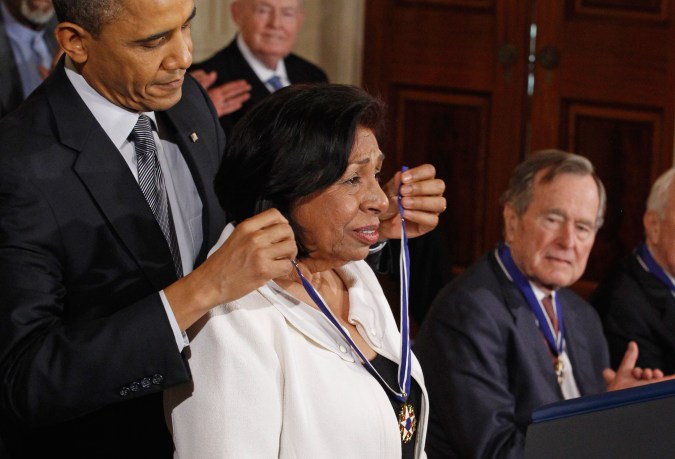Before Brown v. Board of Education ruled that the segregation of public schools violated the 14th Amendment, the landmark case Méndez v. Westminster ended school segregation in California – setting an important precedent for the future. Fueling this case was puertorriqueña Felicitas “La Prieta” Méndez, along with her husband, Gonzalo.
Born in Juncos, Puerto Rico, Felicitas Gómez moved to Arizona with her family at age 12. Hers was one of hundreds of Puerto Rican families recruited to work on cotton fields in Arizona in the 1920s. Within six months of their arrival, her father moved them to California, where Méndez met and married Gonzalo Méndez. The couple established roots – starting a family, a restaurant business, and becoming owners of a farm they had leased for many years.
In the 1940s, when Soledad, Felicitas’ sister-in-law, went to enroll her kids, niece, and nephews at a white school closer to the family farm, a school administrator told her, “Well, you can leave your children here, but you’ll have to take your brother’s kids to a Mexican school.” Soledad’s kids had a lighter complexion and the last name Vidaurri (their father was part French). The Méndez kids had skin like their mother, known as “La Prieta.” Soledad refused the offer; her children wouldn’t attend a school where their cousins weren’t welcome.
“We can do it alone. We have the money right now.”
Soledad’s brother assured her that it must have been a mistake – until officials gave him the same answers they’d given his sister. Livid, Gonzalo requested support from a local Latino organization to challenge the county’s policy of school segregation. They wouldn’t back him. Felicitas intervened on her dejected husbands path and persuaded him to take on the school district independently. Their farm was prospering, she reasoned, “We can do it alone. We have the money right now.”

The couple set out to sue the Westminster school district, but their lawyer made a bigger case of it. Méndez v . Westminster was filed in March of 1945 as a class-action lawsuit against four Orange County school districts so they would be legally forced to integrate. The American Civil Liberties Union, National Association for the Advancement of Colored People, the National Lawyers Guild, the American Jewish Congress, and the Japanese American Citizens League also filed friends of the court briefs in favor of desegregation.
While the lawsuit consumed her husband’s time, Felicitas managed the farm for than a year. Under her leadership, it prospered more than ever before. Revenue from the farm paid for most of the legal proceedings. In addition to lawyer fees, the Méndez couple covered transportation costs and reimbursed pay for theother four families who appeared as witnesses in the case. Felicitas also organizedthe Asociación de Padres y Niños México-Americanos, a group which consisted of mostly farm workers and their families who were in support of the case.
The school district offered a compromise – if Gonzalo dropped the suit, they’d allow his three kids to attend the white elementary school. He refused, saying the the purpose of the lawsuit was to benefit the whole Mexican community, not just a handful of fortunate kids. Felicitas’s racialization informed her fight. In Arizona, people labeled her Black. While in California, they considered her Mexican.
“We had to do it. Our children, all of our children, brown, Black, and white [“bronceados, negros y blancos”] must have the opportunity to be whatever they want to be, and education gives them that opportunity,” she said.
In the final ruling in April 1946, the Ninth Federal Circuit Court of Appeals in San Francisco upheld that segregation practices were unconstitutional and violated the 14th Amendment. Two months after this ruling, the legislature of California passed Assembly Bill 1375, which eliminated all segregation in California schools, including the segregation of Indian, Chinese, Japanese, and Mongolian children. The bill came into law in June 1947 and made California the first state in the country to end school segregation.

Méndez v. Westminster was soon used as precedent for suits against school segregation in Texas, Arizona, and seven years later for the historic Brown v. Board of Education of Topeka, the case that ended legal school segregation in the US in 1954. But it’s mostly a forgotten case – one not taught in school or known to the general public.
In 1998, the year she died, Felicitas attended the groundbreaking of the Gonzalo and Felicitas Méndez Fundamental Intermediate School, a campus named after the couple by the Santa Ana Unified School District. In coming years, a documentary about the case aired on PBS and won an Emmy. Additionally, in 2007, the United States Postal Service created a stamp to commemorate the case, and in 2011, Felicitas daughter received the Presidential Medal of Freedom for her educating others about her parents contributions to racial desegregation.
During one of her last days, Felicitas told her daughter, “We didn’t just do it for you, Sylvia. We did it for all the children…I think this is history of the United States and everybody should know about it, Sylvia.”




